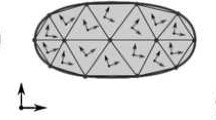Abstract
A flexible body in a multibody system isdescribed only by the position of the nodes in theinertial frame. With this description we can formulatethe mass matrix of the flexible multibody as aconstant matrix. This matrix can be inverted in apreprocessing stage which yields a more efficientacceleration calculation and thus a faster numericalintegration procedure. It also follows from thisdescription of a flexible body that no referenceconditions have to be applied, since the number ofequations used to describe the flexible body is thesame as the number of degrees of freedom. Anotheradvantage of this formulation is that neither thecentrifugal nor the Coriolis forces appear in theequations due to the description of the flexible body.
Similar content being viewed by others
References
Cardona, A. and Geradin, M., ‘Modelling of superelements inmechanism analysis’, International Journal for Numerical Methods in Engineering, 32, 1991, 565–1593.
Cook, R.D., Malkus, D.S. and Plesha, M.E., Concepts and Application of Finite Element Analysis, John Wiley & Sons, New York, 1989, 630.
Crisfield, M.A., Non-Linear Finite Element Analysis of Solids and Structures, Volume 1, John Wiley & Sons, Chichester, 1991, 345.
Haug, E.J., Computer-Aided Kinematics and Dynamics of Mechanical Systems, Volume I: Basic Methods, Allyn and Bacon, Boston, 1989, 498.
Meijaard, J.P., ‘Validation of flexible beam elements in dynamics program, Nonlinear Dynamics, 9, 1996, 21–36.
Moita, G.F. and Crisfield, M.A., ‘A finite element formulation for 3-D continua using the corotational technique’, International Journal for Numerical Methods in Engineering, 39, 1996, 3775–3792.
Nikravesh, P.E., Computer-Aided Analysis of Mechanical Systems, Prentice-Hall, Englewood Cliffs, NJ, 1988, 370.
Pedersen, N.L. and Pedersen, M.L., ‘Adirect derivation of the equations of motion for 3D-flexible mechanical systems’, International Journal for Numerical Methods in Engineering (in press).
Shabana, A.A., Dynamics of Multibody Systems, John Wiley & Sons, New York, 1989, 470.
Shampine, L.F. and Gordon, M.K., Computer Solution of Ordinary Differential Equations The Initial Value Problem, Freeman, San Francisco, 1975.
Simo, J.C. and Vu-Quoc, L., ‘On the dynamics of flexible beams under large overall motions–The plane case Parts I and II’, Journal of Applied Mechanics, 53, 1986, 849–863.
Wittenburg, J., Dynamics of Systems of Rigid Bodies, B.G. Teubner, Stuttgart, 1977, 224.
Wasfy, T.M., ‘Atorsional spring-like beam element for the dynamic analysis of flexible multibody systems’, International Journal for Numerical Methods in Engineering, 39, 1996, 1079–1096.
Wolfram, S., Mathematica, A System for Doing Mathematics by Computer, Wolfram Research, Addison-Wesley, Redwood City, CA, 1988, 749.
Author information
Authors and Affiliations
Rights and permissions
About this article
Cite this article
Pedersen, N.L. On the Formulation of Flexible Multibody Systems with Constant Mass Matrix. Multibody System Dynamics 1, 323–337 (1997). https://doi.org/10.1023/A:1009777019550
Issue Date:
DOI: https://doi.org/10.1023/A:1009777019550




